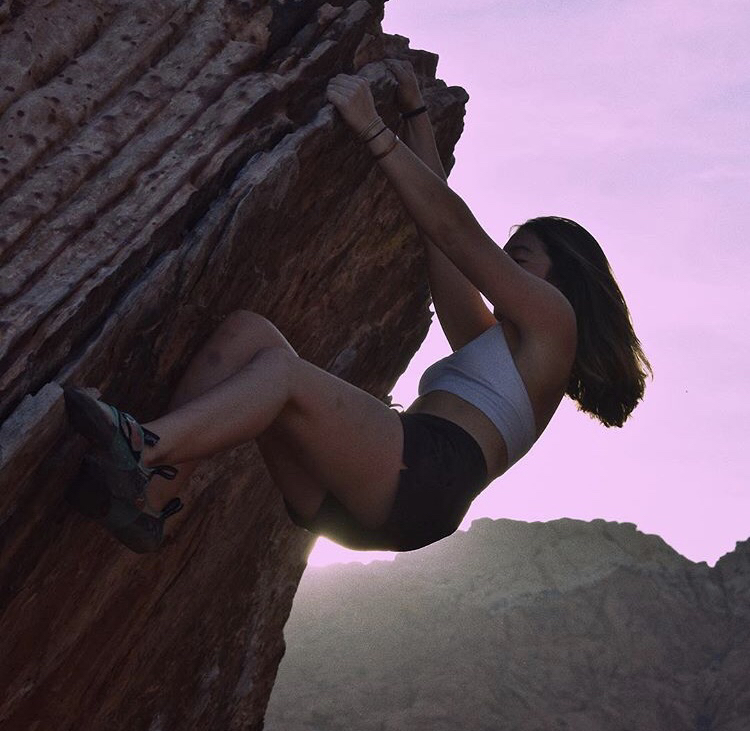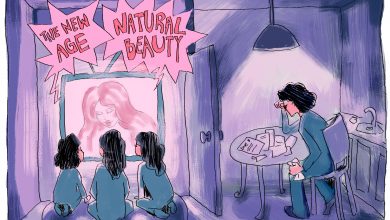Beta Blasting and Biceps: Women in Climbing

Photo by Hal Ford.
“Your arms are bigger than mine!”
“I bet she could beat me in a fight.”
“You’re so buff!’”
While not inherently negative, in a society that forces upon women the idea that smaller is better, statements like these from male classmates caused my already insecure 13-year-old self to obsess over the size and shape of my biceps. I refused to wear sleeveless tops, even in the heat, and did fewer pushups in P.E. class than I could’ve in fear of building larger muscles.
After seven years of worrying about my arm size, I entered a Bay Area climbing gym for the first time after several of my friends took up climbing. What struck me immediately upon walking in was something I had never experienced before — I felt that I was not strong enough. All those years worrying about my strength diminishing my femininity, yet here I was feeling completely weak and inadequate. Surrounded by muscular men monopolizing the wall, yelling out loud grunts and moans between each move, I felt intensely that I did not belong there.
My experience of sexism within climbing culture is not unique. Many women receive skeptical gazes when they hop enthusiastically onto difficult climbs, are forced to step back when a man feels entitled to a crowded climb, and have to fend off men who use climbing as an excuse to hit on women. And my personal favorite, known in the climbing world as “beta blasting” — demonstrating the moves required to complete the climb. Before even attempting a climb, I’d often find myself nodding along as a guy very carefully explained to me each foot placement and body position, even on easy climbs. Climbing and mansplaining go hand-in-hand: whenever women enter a field traditionally reserved for men, it’s unsurprising that men would take it upon themselves to give unsolicited direction.
I was initially overwhelmed with frustration about the gender inequality and assumed inadequacy of women climbers. What I discovered after some self-reflection and discussion with other women climbers, however, is not a story about feeling out of place in a male-dominated sport, but rather a story about finding empowerment, a home within one’s body, and a community of women who support each other unconditionally. This was exemplified when I asked my friend if she wanted to say anything about her experience as a female climber, to which she responded, “I have some good shit to say about empowerment.” I realized that the true climbing experience for women is not one of constant disheartenment over gender stereotypes and misogyny. Rather, these issues have always been secondary to the benefit of having a community of strong, supportive, and badass women.
While the experiences of female climbers are speckled with conflicts with male egos and a male-dominated sport, most women I know are more eager to tell you about the first time they sent a V7 — a difficult grade of climbing — or the time they went to Joshua Tree and finally finished a climb that they were working on for months. Lily Devecchi, a frequent climber, embodied this enthusiasm for climbing, claiming that people of all genders “problem solve together to get stronger every day to be able to do what we truly love.”
Climbing fosters not only a sense of support between women, but also a trust in oneself. It teaches us to connect with and depend on our bodies, which is valuable in a culture that often makes it difficult for women to have a good relationship with their bodies: according to a study in the European Eating Disorders Review, 87 percent of women report wanting a smaller silhouette. It is empowering to participate in a sport where you are forced to trust your own strength. Especially in outdoor climbing, where falling can cause serious injury, climbing allows me to see my body as a support, rather than something to be critiqued.
Women climbers don’t necessarily set out to resist male superiority and pursue gender equality. Instead, they are simply a community of women who go out and do what they love, brushing off the stereotypes and expectations of women in the process. We harness up and joyfully compare our growing biceps without batting an eye.
Women climbers quickly learn how to navigate sexism in the climbing gym in order to create a space that feels like their own. From the very beginning, my friends taught me how to ignore the guys who would hop on a climb I was struggling with just to prove how effortlessly they could do it, and to brush off their comments about me only being able to complete a climb because “girls are more flexible.” Some women climbers tackle gender stereotypes head-on by making sure to take up space in the gym, to not shy away from hard climbs, and to cheer each other on and tape each other’s bleeding hands.
This refusal to succumb to gender stereotypes is a defining trait of women climbers. One of the first times I climbed, I overheard one female climber exclaim “You’re SO big!” to another in sheer joy and excitement. I was taken aback by her applause over the large size of her friend’s arms. While it’s not shocking that athletes would compliment each other on the mass of their muscles, I realized I had never really heard someone compliment a woman on the size of her biceps and shoulders.
Even as a progressive thinker and feminist, it was so easy for me to categorize women either as warriors against gender inequality — an intentional role which requires emotional labor — or victims of an oppressive society. This urge to classify women into these two categories is common, as the “dichotomy between women’s victimization and women’s agency is a central tension within feminism”. What this dichotomy leaves out, however, are the women who find ways to empower themselves in their daily lives doing what they love and, in turn, naturally end up becoming part of a culture that resists gender stereotypes and broadens the scope of what are considered socially acceptable activities for women.
It is this category that female climbers hoist themselves into.




